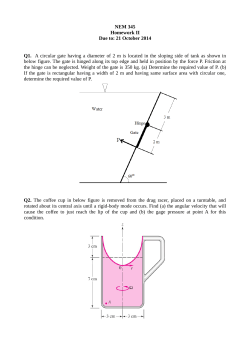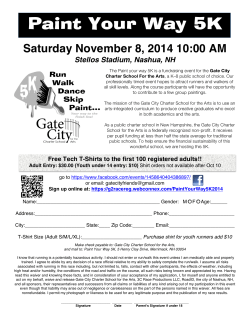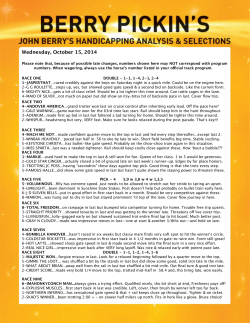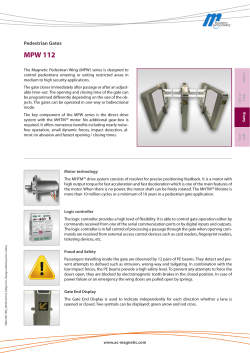
Failure of spillway radial gate of Narayanapur Dam â a case study N
First National Dam Safety Conference,Chennai Failure of spillway radial gate of Narayanapur Dam – a case study 25‐3‐2015 Technical Session:6 N.Srinivas Superintending Engineer , Water Resources Development Organization, Govt. of Karnataka, Bangalore E‐mail: srinivasn65@gmail.com Government of Karnataka Water Resources Department Panoramic view of Narayanapur Dam Narayanapur Dam – Salient Features • • • • • • • • • River : Krishna. Location : Siddapur Village, Bijapur District, Karnataka. Gross and Live storage : 37.646 and 30.473 TMC ft. Water Spread Area : 134.50 Sq.km. Full Reservoir Level : 492.252 M Design flood : 13,40,000 cusecs. Dam Type : Composite Gravity Dam Dam Height : 25.812 M Dam Length : 10.64 Km a) Concrete Spillway dam : 548.00 M b) Masonry non‐spillway dam : 673 M c ) Earthen dam including dyke : 9,416 M OVERVIEW • • • • • Narayanapur Dam – Salient features Genesis of gate failure – distress signals Gate failure – event, findings and recommendations Implementation and way forward. Conclusions Narayanapur Dam – Spillway Gates • Total Gates • • • • • : 30 Nos. Radial Gates a) Main spillway : 25 gates b) Auxiliary spillway : 05 gates Size : 15 M x 12 M height (45000 Cusecs) Operation : Electrical ‐ Rope drum hoists Commissioning : 1982 to 1984 Design & Erection : T.S.P Ltd and Sikka & Sikka Ltd Spillway capacity : Discharge of 13,40,000 cusecs with a frequency of 1 in 10,000 years with 10% of the gates in non‐operation condition. GENESIS OF SPILLWAY GATE FAILURE – DISTRESS SIGNALS • Nov‐1990‐91 : Failure of weld joints between Trunnion and tie beam of gate Nos. 3, 6, and 15 ‐‐ Rectification by way of providing additional plates by M/s TSP Ltd • Nov‐1992 : Auxiliary spillway gate No. 5 damaged Cause : Failure of the bulk head gate • Committee findings : a) Bulk head gate erected in additional bay No.5 was not removed even after commissioning of additional spillway radial gates in 1984. b) Cracks in defective welds of structures not visible initially but propagate progressively over a period of time due to stress and corrosion ‐ leads to Failure GENESIS OF SPILLWAY GATE FAILURE – DISTRESS SIGNALS • Inherent short falls : a) Deficiency in the welds b) Erection defects like non‐matching of skin plate & wall plate, improper fixing of wall plate to the designed vent width & loss of curvature of skin plate during erection • Gates Inspection findings : a) welding poor at crucial locations and ( BY TSP LTD‐ 1993) formation of scale b) Bottom portion of the pedestal lifted up to 10 mm and gap exists between rest beam and pedestal • Recommendation : a) Additional stiffener plates to be welded on both sides of the tie girder and trunnion b) Alignment of trunnion centre to centre to be checked c) Thrust block arrangement required • Remedial Action : New radial gate erected in auxiliary spillway No.5 DAY OF CALAMITY ‐ FAILURE OF MAIN SPILLWAY GATE NO.5 ON 6‐10‐2005 • 6‐10‐2005 : Storage at FRL 492.252 M and central spillway gates in open position & Surplussing • 6‐10‐2005 : Main spillway gate No.5 dislodged when in closed (11 AM) position from its location and pushed into the river bed downstream • 7‐10‐2005 : Experts Inspection and depletion of Reservoir up to R.L 486.50 – 20 TMC Ft water let out • 8‐10‐2005 to 10‐10‐2005 lowering of 7 Nos. Stop log elements under flowing water conditions in Vent No.5 and flow stopped with sustained efforts Downstream view of Narayanpur Dam during flood regulation Flow through main spillway vent no.5 stopped by lowering stoplog elements. Assessed Sequence of failure of gate No.5 2005 – Sri.D.N.Desai Investigation Committee’s findings SEQUENCE 1. Failure of joint between the yoke girder and Trunnion EFFECT 1. Trunnion disturbed resulting in huge strain at the junction of arms and Trunnion 2. Entire load of the gate came on the left arm assembly 2. Bolts connecting the Trunnion to the rest beam snapped 3. In the absence of support on downstream side, Skin plate assembly along with horizontal girder was held only by wire ropes on upstream side 3. Wire ropes could not hold the gate in position against the huge water load and eventually snapped its connection with the skin plate. Assessed Sequence of failure of gate No.5 ‐ Committee’s findings contd.. SEQUENCE 4. Entire skin plate assembly with horizontal girders, left side arm assembly with Trunnion slided along the spillway profile EFFECT 4. Due to high velocity flow, Gate assembly pushed out of the spillway bucket and moved nearly 100 feet into the river. 5. Right arm assembly with Trunnion also slided along the spillway profile 5. Right arm assembly with Trunnion also transported by high velocity flow into the river bed near about the skin plate assembly. Photo showing the damaged skin plate assembly of gate no.5 on downstream side Photos – Before and after the failure of gate No‐5 Failed Weld joints between tie beam and Trunnion proper. Typical Tie beam joint before failure Spillway gate No.5 ‐Tie beam Left side joint (weld joint not to the designed penetration thickness) Photos – Before and after the failure of gate No‐5 Spill way Gate No. 5 ‐ Tie beam Right side weld joint (Weld not properly penetrated up to the Trunnion proper, as there is no 100 % weld penetration, rods and plates are found to be placed in weld gaps.) Causes for failure of the gate No.5 – Committee’s Findings & Recommendations • Failure of the fillet welded joints at the junction of the tie beam between Trunnions and Trunnion proper • Weld failure due to progressive rusting along the inside surface of the weld over a period of time due to ingress of moisture and water. • Inadequate Inspection and maintenance, limited to lubrication, replacement of wire ropes & seals and periodic painting in the successive years • Recommendations a) All weld joints be redone to the designed thickness b) Scale formations on skin plates to be removed and painted c) Replace stiffeners which have lost thickness by more than 2 mm d) Strengthen the joints of Trunnion tie and joint between tie beam and the Trunnions Implementation – Way forward • Damaged gate replaced with a new radial gate during April‐2007 and other recommendations of the committee implemented in a phased manner from 2007 to 2011 • Narayanapur dam included in DRIP for comprehensive Interventions, both for civil structures and Electro‐ Mechanical components • Provision for Zinc Metalizing to the corroded gate components such as skin plate, stiffeners, vertical girders and horizontal girders at an estimated cost of 10.16 crore. • To augment emergency preparedness, provision for 84 ton capacity Gantry crane and one set of stop log gates at an estimated cost of 5.35 crore. Tie beam strengthening attended to all the spillway gates Conclusion • Hydro‐Mechanical components of a dam are as important as the main structure and need utmost attention towards their upkeep and maintenance with systematic regular inspections . • They are the life lines for storage and Safe discharge of floods. • Impetus towards modern techniques such as thermal imaging and ultra sound for detection of structural deficiencies and weld cracks is essential • Stocking welding equipment, gas cylinders & gas cutting equipments, released wire ropes & clamps and chain & pulley blocks to tide over the emergency in case of failure of gates be made mandatory . • Involvement of all officers up to the level of Chief Engineer for pre‐monsoon and post‐monsoon inspection of dams • Strict compliance of the Dam Safety Review Panel (DSRP) recommendations THANK Y0U
© Copyright 2025











